MN4063QA: Comprehensive Report on Understanding and Managing Data
VerifiedAdded on 2023/06/14
|12
|1827
|53
Report
AI Summary
This report, likely for the course MN4063QA, delves into understanding and managing data through various analytical techniques. It covers statistical calculations like variance, standard deviation, and mean, along with their interpretation. The report also explores time series and cross-sectional data, network diagrams for project management including critical path analysis, and correlation matrices to identify predictors of quarterly revenue. Furthermore, it includes break-even analysis, cost estimation using the high-low method, and margin of safety calculations. The report concludes with a reflection on the learning outcomes and skills developed through the project. This document is available on Desklib, where students can access a wealth of study resources including past papers and solved assignments.
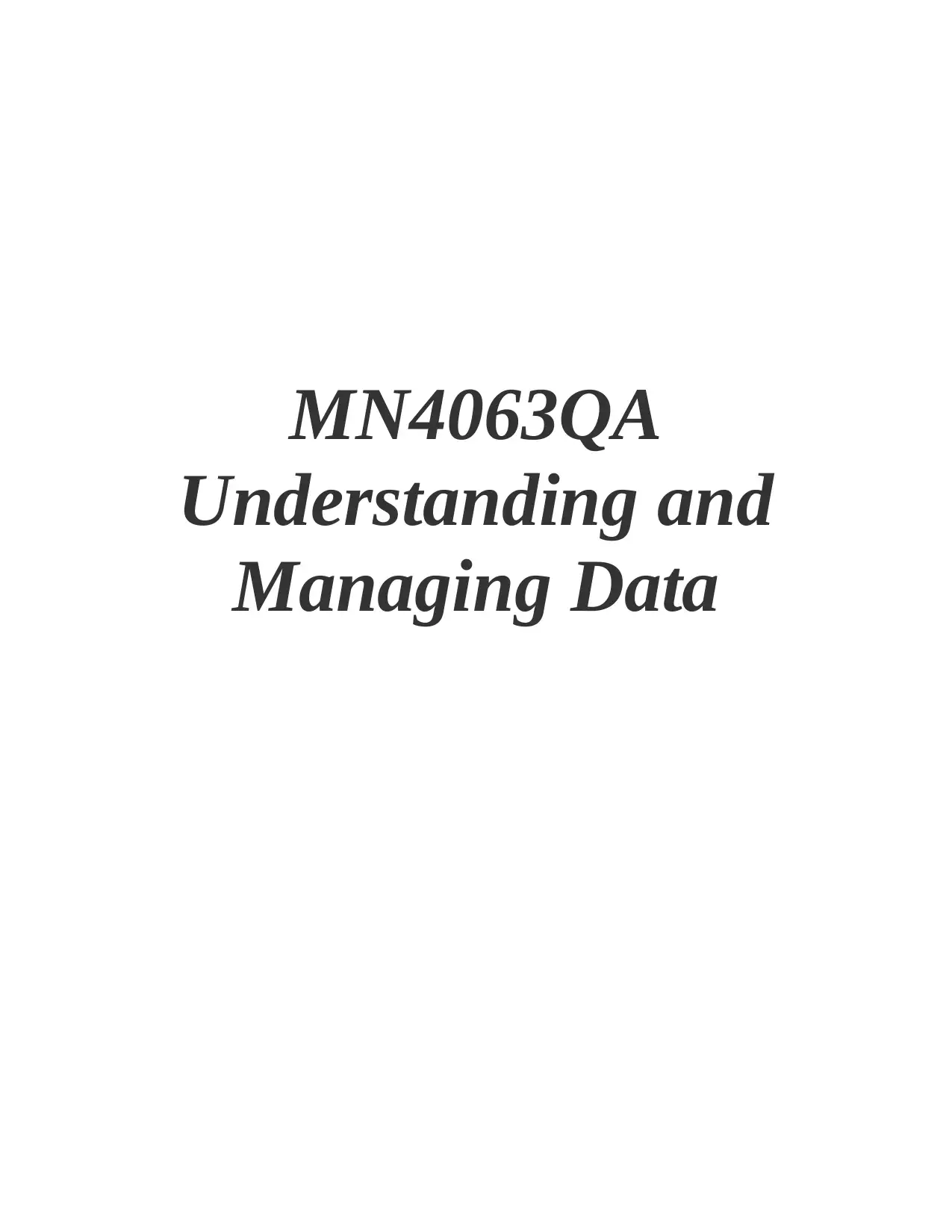
MN4063QA
Understanding and
Managing Data
Understanding and
Managing Data
Paraphrase This Document
Need a fresh take? Get an instant paraphrase of this document with our AI Paraphraser
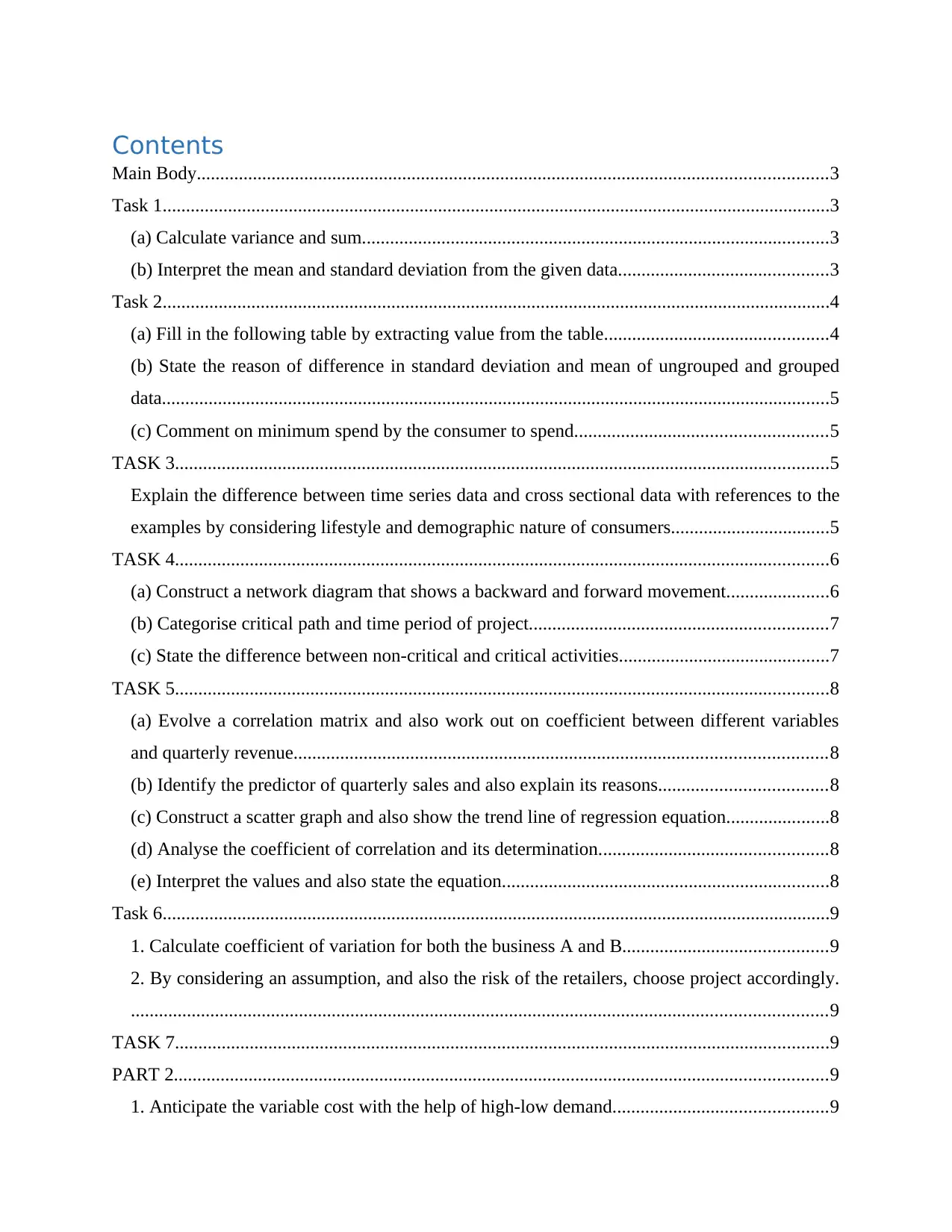
Contents
Main Body.......................................................................................................................................3
Task 1...............................................................................................................................................3
(a) Calculate variance and sum....................................................................................................3
(b) Interpret the mean and standard deviation from the given data.............................................3
Task 2...............................................................................................................................................4
(a) Fill in the following table by extracting value from the table................................................4
(b) State the reason of difference in standard deviation and mean of ungrouped and grouped
data...............................................................................................................................................5
(c) Comment on minimum spend by the consumer to spend......................................................5
TASK 3............................................................................................................................................5
Explain the difference between time series data and cross sectional data with references to the
examples by considering lifestyle and demographic nature of consumers..................................5
TASK 4............................................................................................................................................6
(a) Construct a network diagram that shows a backward and forward movement......................6
(b) Categorise critical path and time period of project................................................................7
(c) State the difference between non-critical and critical activities.............................................7
TASK 5............................................................................................................................................8
(a) Evolve a correlation matrix and also work out on coefficient between different variables
and quarterly revenue..................................................................................................................8
(b) Identify the predictor of quarterly sales and also explain its reasons....................................8
(c) Construct a scatter graph and also show the trend line of regression equation......................8
(d) Analyse the coefficient of correlation and its determination.................................................8
(e) Interpret the values and also state the equation......................................................................8
Task 6...............................................................................................................................................9
1. Calculate coefficient of variation for both the business A and B............................................9
2. By considering an assumption, and also the risk of the retailers, choose project accordingly.
.....................................................................................................................................................9
TASK 7............................................................................................................................................9
PART 2............................................................................................................................................9
1. Anticipate the variable cost with the help of high-low demand..............................................9
Main Body.......................................................................................................................................3
Task 1...............................................................................................................................................3
(a) Calculate variance and sum....................................................................................................3
(b) Interpret the mean and standard deviation from the given data.............................................3
Task 2...............................................................................................................................................4
(a) Fill in the following table by extracting value from the table................................................4
(b) State the reason of difference in standard deviation and mean of ungrouped and grouped
data...............................................................................................................................................5
(c) Comment on minimum spend by the consumer to spend......................................................5
TASK 3............................................................................................................................................5
Explain the difference between time series data and cross sectional data with references to the
examples by considering lifestyle and demographic nature of consumers..................................5
TASK 4............................................................................................................................................6
(a) Construct a network diagram that shows a backward and forward movement......................6
(b) Categorise critical path and time period of project................................................................7
(c) State the difference between non-critical and critical activities.............................................7
TASK 5............................................................................................................................................8
(a) Evolve a correlation matrix and also work out on coefficient between different variables
and quarterly revenue..................................................................................................................8
(b) Identify the predictor of quarterly sales and also explain its reasons....................................8
(c) Construct a scatter graph and also show the trend line of regression equation......................8
(d) Analyse the coefficient of correlation and its determination.................................................8
(e) Interpret the values and also state the equation......................................................................8
Task 6...............................................................................................................................................9
1. Calculate coefficient of variation for both the business A and B............................................9
2. By considering an assumption, and also the risk of the retailers, choose project accordingly.
.....................................................................................................................................................9
TASK 7............................................................................................................................................9
PART 2............................................................................................................................................9
1. Anticipate the variable cost with the help of high-low demand..............................................9
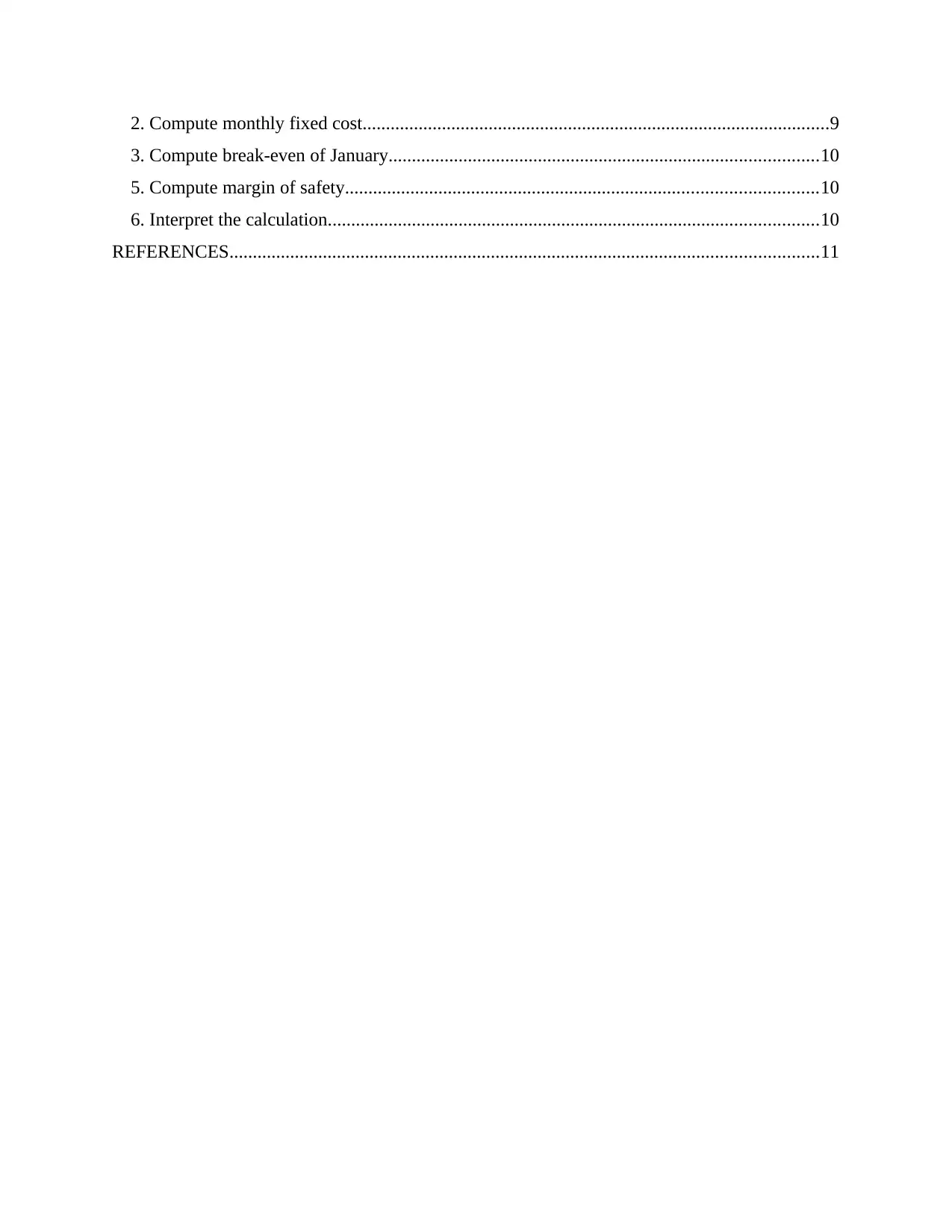
2. Compute monthly fixed cost....................................................................................................9
3. Compute break-even of January............................................................................................10
5. Compute margin of safety.....................................................................................................10
6. Interpret the calculation.........................................................................................................10
REFERENCES..............................................................................................................................11
3. Compute break-even of January............................................................................................10
5. Compute margin of safety.....................................................................................................10
6. Interpret the calculation.........................................................................................................10
REFERENCES..............................................................................................................................11
⊘ This is a preview!⊘
Do you want full access?
Subscribe today to unlock all pages.

Trusted by 1+ million students worldwide
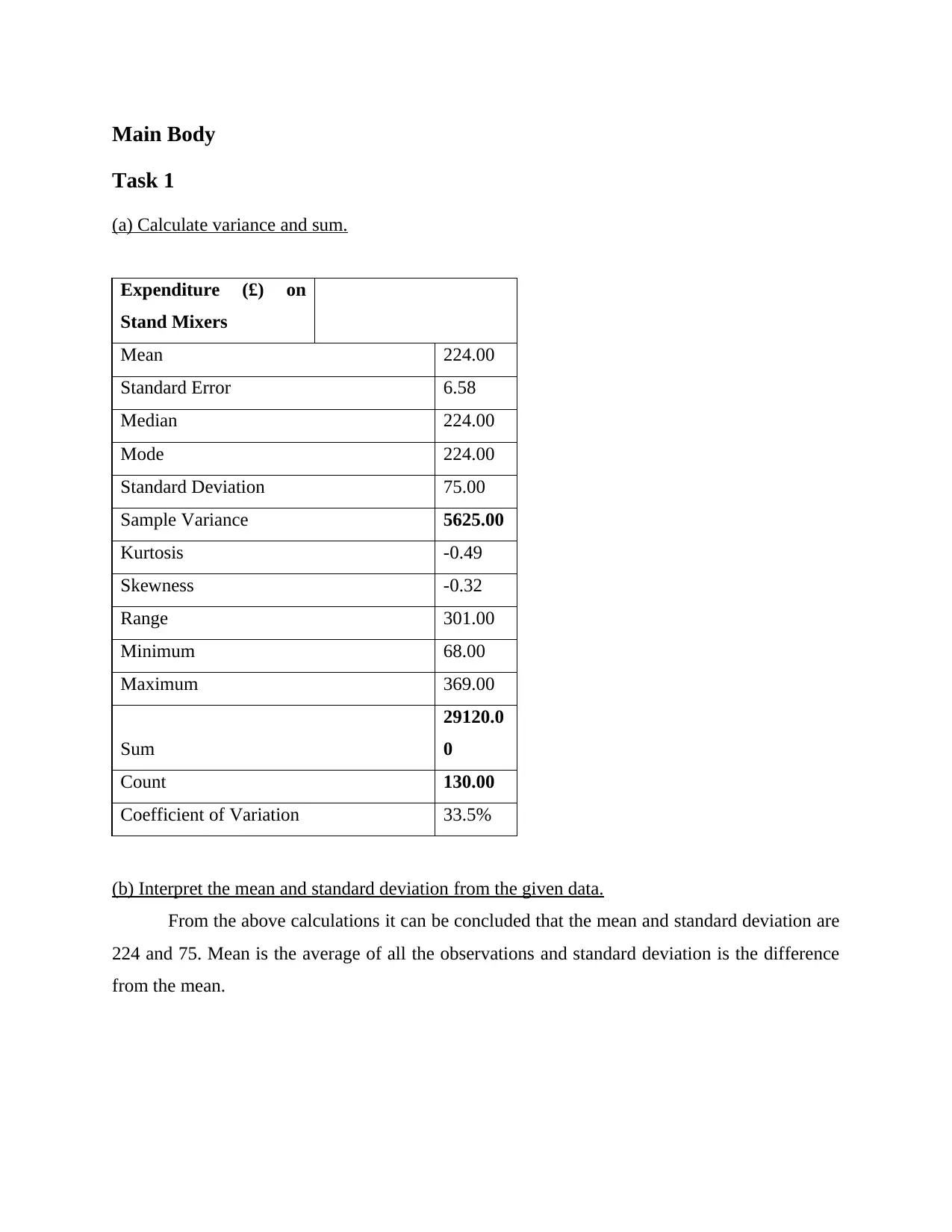
Main Body
Task 1
(a) Calculate variance and sum.
Expenditure (£) on
Stand Mixers
Mean 224.00
Standard Error 6.58
Median 224.00
Mode 224.00
Standard Deviation 75.00
Sample Variance 5625.00
Kurtosis -0.49
Skewness -0.32
Range 301.00
Minimum 68.00
Maximum 369.00
Sum
29120.0
0
Count 130.00
Coefficient of Variation 33.5%
(b) Interpret the mean and standard deviation from the given data.
From the above calculations it can be concluded that the mean and standard deviation are
224 and 75. Mean is the average of all the observations and standard deviation is the difference
from the mean.
Task 1
(a) Calculate variance and sum.
Expenditure (£) on
Stand Mixers
Mean 224.00
Standard Error 6.58
Median 224.00
Mode 224.00
Standard Deviation 75.00
Sample Variance 5625.00
Kurtosis -0.49
Skewness -0.32
Range 301.00
Minimum 68.00
Maximum 369.00
Sum
29120.0
0
Count 130.00
Coefficient of Variation 33.5%
(b) Interpret the mean and standard deviation from the given data.
From the above calculations it can be concluded that the mean and standard deviation are
224 and 75. Mean is the average of all the observations and standard deviation is the difference
from the mean.
Paraphrase This Document
Need a fresh take? Get an instant paraphrase of this document with our AI Paraphraser
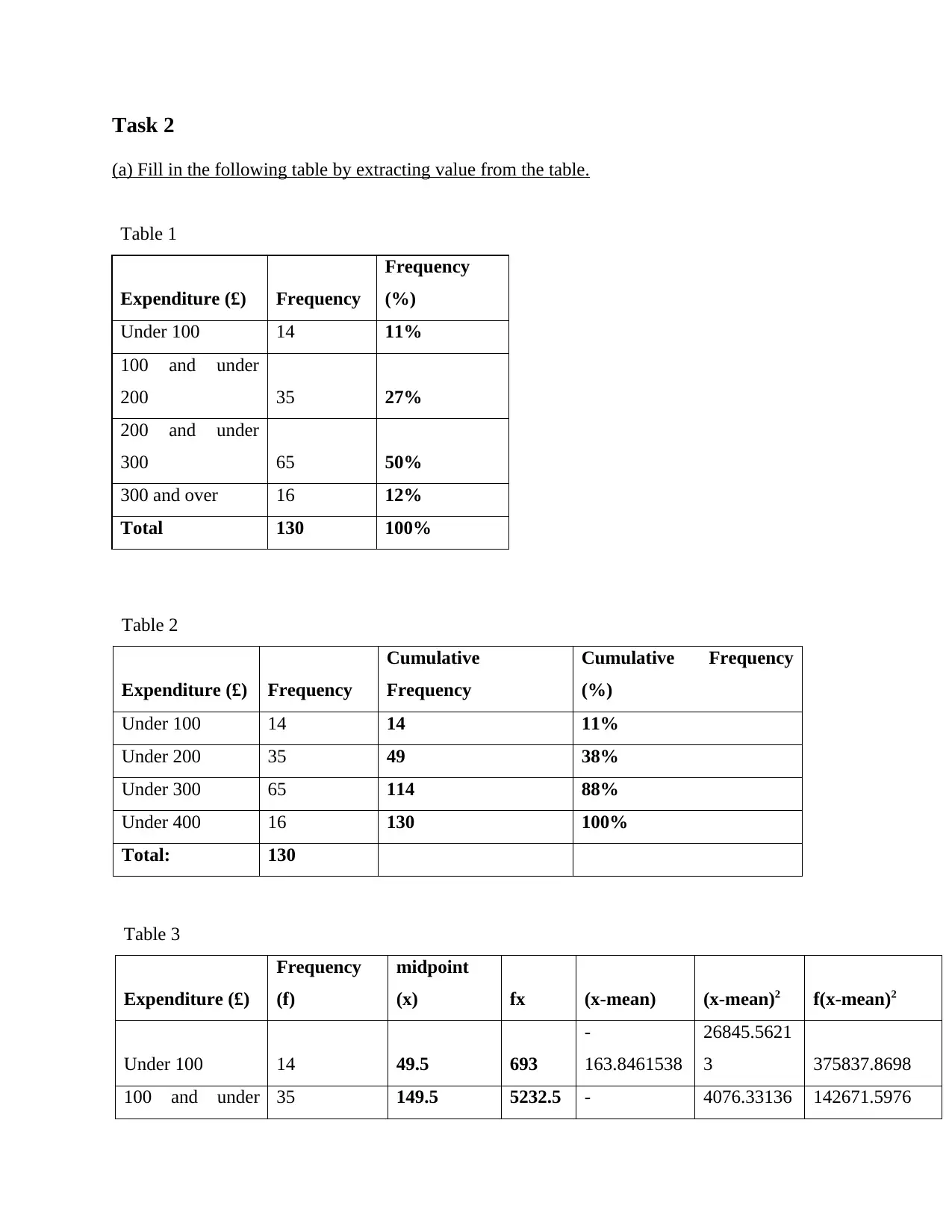
Task 2
(a) Fill in the following table by extracting value from the table.
Table 1
Expenditure (£) Frequency
Frequency
(%)
Under 100 14 11%
100 and under
200 35 27%
200 and under
300 65 50%
300 and over 16 12%
Total 130 100%
Table 2
Expenditure (£) Frequency
Cumulative
Frequency
Cumulative Frequency
(%)
Under 100 14 14 11%
Under 200 35 49 38%
Under 300 65 114 88%
Under 400 16 130 100%
Total: 130
Table 3
Expenditure (£)
Frequency
(f)
midpoint
(x) fx (x-mean) (x-mean)2 f(x-mean)2
Under 100 14 49.5 693
-
163.8461538
26845.5621
3 375837.8698
100 and under 35 149.5 5232.5 - 4076.33136 142671.5976
(a) Fill in the following table by extracting value from the table.
Table 1
Expenditure (£) Frequency
Frequency
(%)
Under 100 14 11%
100 and under
200 35 27%
200 and under
300 65 50%
300 and over 16 12%
Total 130 100%
Table 2
Expenditure (£) Frequency
Cumulative
Frequency
Cumulative Frequency
(%)
Under 100 14 14 11%
Under 200 35 49 38%
Under 300 65 114 88%
Under 400 16 130 100%
Total: 130
Table 3
Expenditure (£)
Frequency
(f)
midpoint
(x) fx (x-mean) (x-mean)2 f(x-mean)2
Under 100 14 49.5 693
-
163.8461538
26845.5621
3 375837.8698
100 and under 35 149.5 5232.5 - 4076.33136 142671.5976
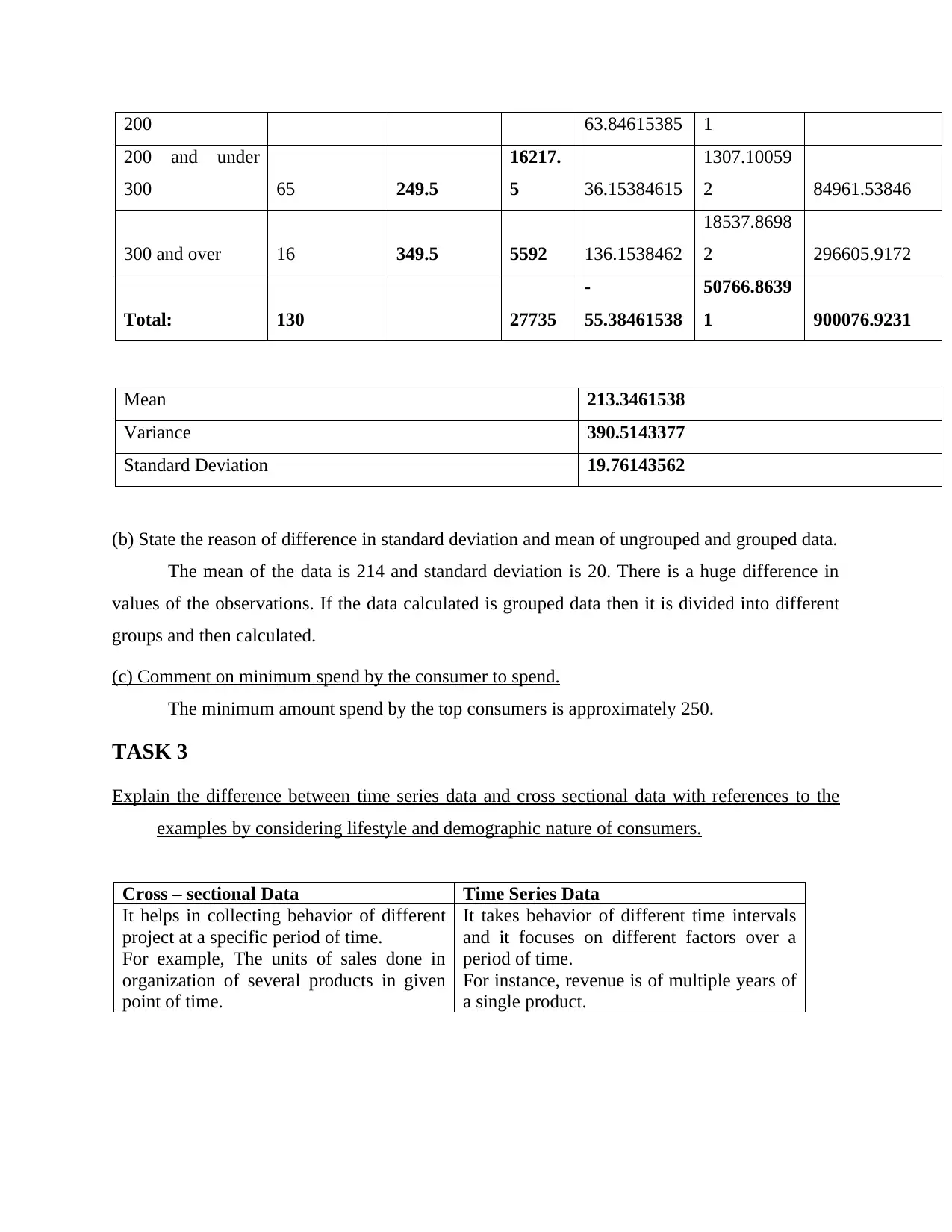
200 63.84615385 1
200 and under
300 65 249.5
16217.
5 36.15384615
1307.10059
2 84961.53846
300 and over 16 349.5 5592 136.1538462
18537.8698
2 296605.9172
Total: 130 27735
-
55.38461538
50766.8639
1 900076.9231
Mean 213.3461538
Variance 390.5143377
Standard Deviation 19.76143562
(b) State the reason of difference in standard deviation and mean of ungrouped and grouped data.
The mean of the data is 214 and standard deviation is 20. There is a huge difference in
values of the observations. If the data calculated is grouped data then it is divided into different
groups and then calculated.
(c) Comment on minimum spend by the consumer to spend.
The minimum amount spend by the top consumers is approximately 250.
TASK 3
Explain the difference between time series data and cross sectional data with references to the
examples by considering lifestyle and demographic nature of consumers.
Cross – sectional Data Time Series Data
It helps in collecting behavior of different
project at a specific period of time.
For example, The units of sales done in
organization of several products in given
point of time.
It takes behavior of different time intervals
and it focuses on different factors over a
period of time.
For instance, revenue is of multiple years of
a single product.
200 and under
300 65 249.5
16217.
5 36.15384615
1307.10059
2 84961.53846
300 and over 16 349.5 5592 136.1538462
18537.8698
2 296605.9172
Total: 130 27735
-
55.38461538
50766.8639
1 900076.9231
Mean 213.3461538
Variance 390.5143377
Standard Deviation 19.76143562
(b) State the reason of difference in standard deviation and mean of ungrouped and grouped data.
The mean of the data is 214 and standard deviation is 20. There is a huge difference in
values of the observations. If the data calculated is grouped data then it is divided into different
groups and then calculated.
(c) Comment on minimum spend by the consumer to spend.
The minimum amount spend by the top consumers is approximately 250.
TASK 3
Explain the difference between time series data and cross sectional data with references to the
examples by considering lifestyle and demographic nature of consumers.
Cross – sectional Data Time Series Data
It helps in collecting behavior of different
project at a specific period of time.
For example, The units of sales done in
organization of several products in given
point of time.
It takes behavior of different time intervals
and it focuses on different factors over a
period of time.
For instance, revenue is of multiple years of
a single product.
⊘ This is a preview!⊘
Do you want full access?
Subscribe today to unlock all pages.

Trusted by 1+ million students worldwide
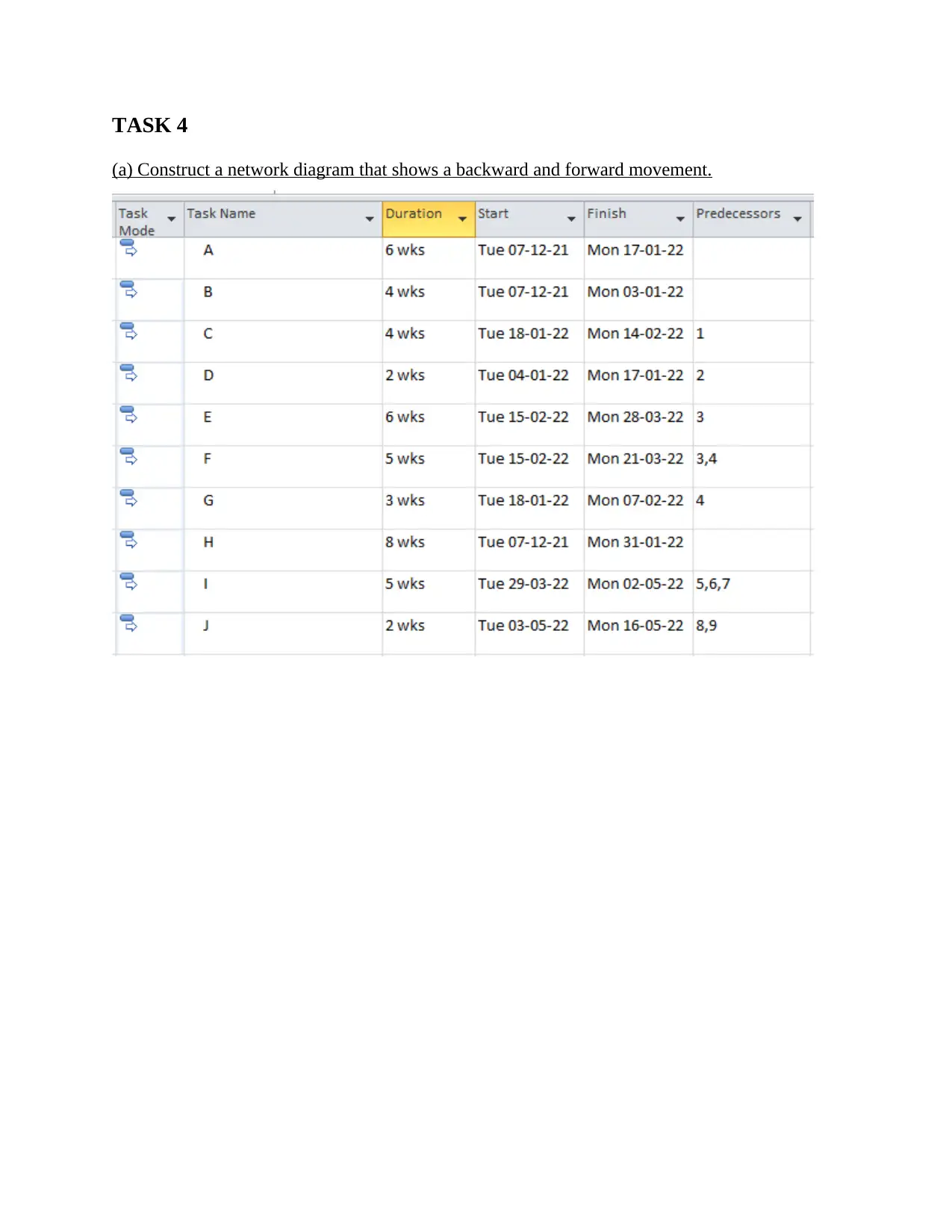
TASK 4
(a) Construct a network diagram that shows a backward and forward movement.
(a) Construct a network diagram that shows a backward and forward movement.
Paraphrase This Document
Need a fresh take? Get an instant paraphrase of this document with our AI Paraphraser
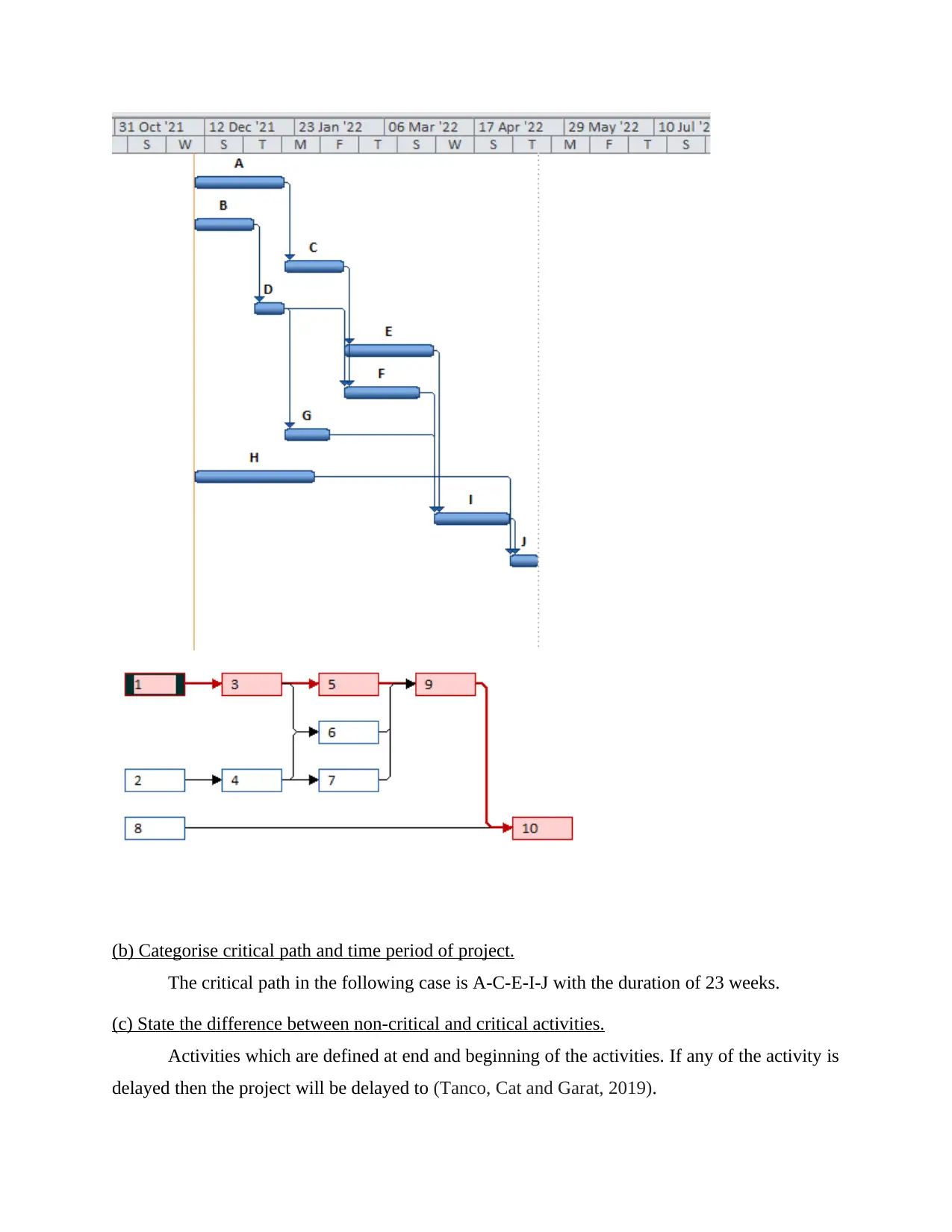
(b) Categorise critical path and time period of project.
The critical path in the following case is A-C-E-I-J with the duration of 23 weeks.
(c) State the difference between non-critical and critical activities.
Activities which are defined at end and beginning of the activities. If any of the activity is
delayed then the project will be delayed to (Tanco, Cat and Garat, 2019).
The critical path in the following case is A-C-E-I-J with the duration of 23 weeks.
(c) State the difference between non-critical and critical activities.
Activities which are defined at end and beginning of the activities. If any of the activity is
delayed then the project will be delayed to (Tanco, Cat and Garat, 2019).
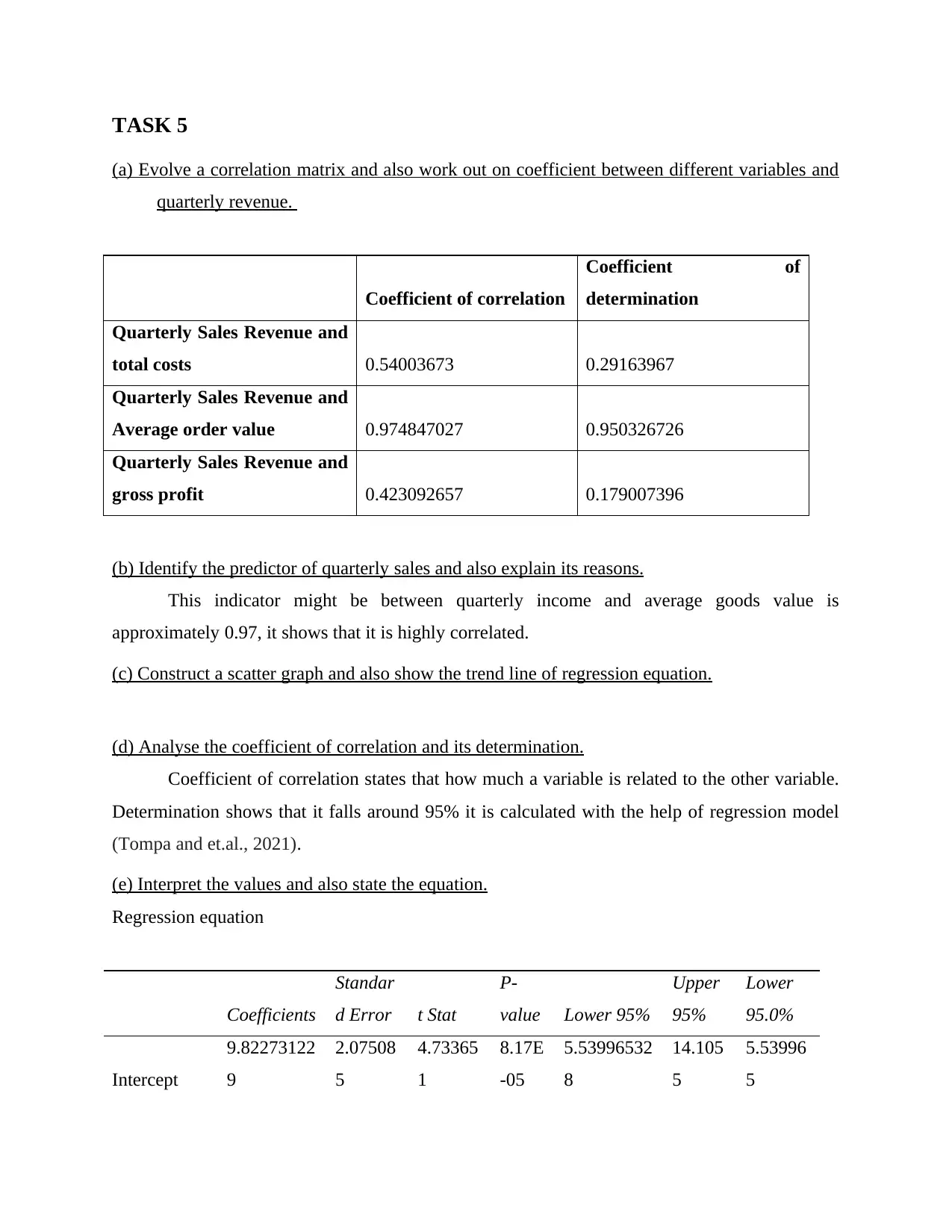
TASK 5
(a) Evolve a correlation matrix and also work out on coefficient between different variables and
quarterly revenue.
Coefficient of correlation
Coefficient of
determination
Quarterly Sales Revenue and
total costs 0.54003673 0.29163967
Quarterly Sales Revenue and
Average order value 0.974847027 0.950326726
Quarterly Sales Revenue and
gross profit 0.423092657 0.179007396
(b) Identify the predictor of quarterly sales and also explain its reasons.
This indicator might be between quarterly income and average goods value is
approximately 0.97, it shows that it is highly correlated.
(c) Construct a scatter graph and also show the trend line of regression equation.
(d) Analyse the coefficient of correlation and its determination.
Coefficient of correlation states that how much a variable is related to the other variable.
Determination shows that it falls around 95% it is calculated with the help of regression model
(Tompa and et.al., 2021).
(e) Interpret the values and also state the equation.
Regression equation
Coefficients
Standar
d Error t Stat
P-
value Lower 95%
Upper
95%
Lower
95.0%
Intercept
9.82273122
9
2.07508
5
4.73365
1
8.17E
-05
5.53996532
8
14.105
5
5.53996
5
(a) Evolve a correlation matrix and also work out on coefficient between different variables and
quarterly revenue.
Coefficient of correlation
Coefficient of
determination
Quarterly Sales Revenue and
total costs 0.54003673 0.29163967
Quarterly Sales Revenue and
Average order value 0.974847027 0.950326726
Quarterly Sales Revenue and
gross profit 0.423092657 0.179007396
(b) Identify the predictor of quarterly sales and also explain its reasons.
This indicator might be between quarterly income and average goods value is
approximately 0.97, it shows that it is highly correlated.
(c) Construct a scatter graph and also show the trend line of regression equation.
(d) Analyse the coefficient of correlation and its determination.
Coefficient of correlation states that how much a variable is related to the other variable.
Determination shows that it falls around 95% it is calculated with the help of regression model
(Tompa and et.al., 2021).
(e) Interpret the values and also state the equation.
Regression equation
Coefficients
Standar
d Error t Stat
P-
value Lower 95%
Upper
95%
Lower
95.0%
Intercept
9.82273122
9
2.07508
5
4.73365
1
8.17E
-05
5.53996532
8
14.105
5
5.53996
5
⊘ This is a preview!⊘
Do you want full access?
Subscribe today to unlock all pages.

Trusted by 1+ million students worldwide
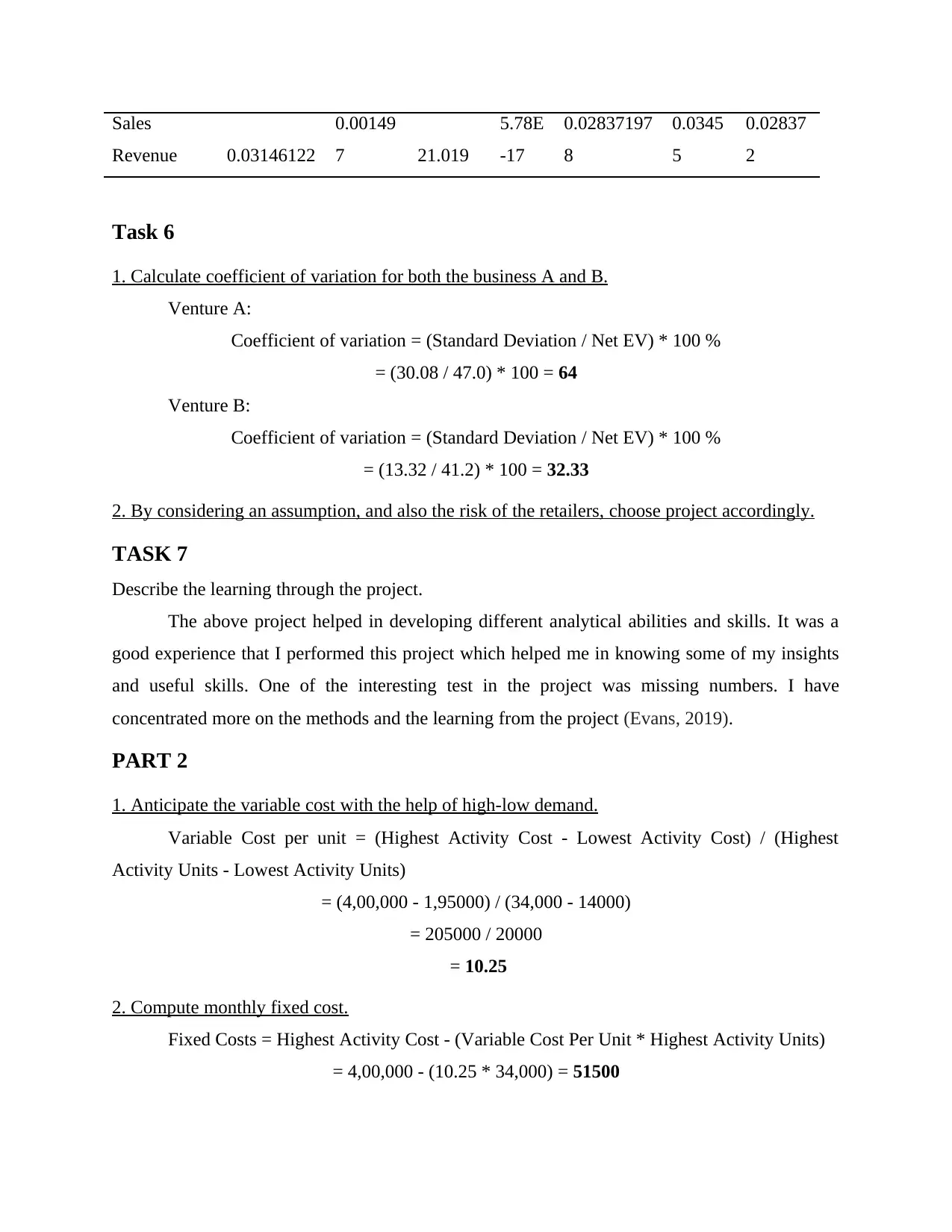
Sales
Revenue 0.03146122
0.00149
7 21.019
5.78E
-17
0.02837197
8
0.0345
5
0.02837
2
Task 6
1. Calculate coefficient of variation for both the business A and B.
Venture A:
Coefficient of variation = (Standard Deviation / Net EV) * 100 %
= (30.08 / 47.0) * 100 = 64
Venture B:
Coefficient of variation = (Standard Deviation / Net EV) * 100 %
= (13.32 / 41.2) * 100 = 32.33
2. By considering an assumption, and also the risk of the retailers, choose project accordingly.
TASK 7
Describe the learning through the project.
The above project helped in developing different analytical abilities and skills. It was a
good experience that I performed this project which helped me in knowing some of my insights
and useful skills. One of the interesting test in the project was missing numbers. I have
concentrated more on the methods and the learning from the project (Evans, 2019).
PART 2
1. Anticipate the variable cost with the help of high-low demand.
Variable Cost per unit = (Highest Activity Cost - Lowest Activity Cost) / (Highest
Activity Units - Lowest Activity Units)
= (4,00,000 - 1,95000) / (34,000 - 14000)
= 205000 / 20000
= 10.25
2. Compute monthly fixed cost.
Fixed Costs = Highest Activity Cost - (Variable Cost Per Unit * Highest Activity Units)
= 4,00,000 - (10.25 * 34,000) = 51500
Revenue 0.03146122
0.00149
7 21.019
5.78E
-17
0.02837197
8
0.0345
5
0.02837
2
Task 6
1. Calculate coefficient of variation for both the business A and B.
Venture A:
Coefficient of variation = (Standard Deviation / Net EV) * 100 %
= (30.08 / 47.0) * 100 = 64
Venture B:
Coefficient of variation = (Standard Deviation / Net EV) * 100 %
= (13.32 / 41.2) * 100 = 32.33
2. By considering an assumption, and also the risk of the retailers, choose project accordingly.
TASK 7
Describe the learning through the project.
The above project helped in developing different analytical abilities and skills. It was a
good experience that I performed this project which helped me in knowing some of my insights
and useful skills. One of the interesting test in the project was missing numbers. I have
concentrated more on the methods and the learning from the project (Evans, 2019).
PART 2
1. Anticipate the variable cost with the help of high-low demand.
Variable Cost per unit = (Highest Activity Cost - Lowest Activity Cost) / (Highest
Activity Units - Lowest Activity Units)
= (4,00,000 - 1,95000) / (34,000 - 14000)
= 205000 / 20000
= 10.25
2. Compute monthly fixed cost.
Fixed Costs = Highest Activity Cost - (Variable Cost Per Unit * Highest Activity Units)
= 4,00,000 - (10.25 * 34,000) = 51500
Paraphrase This Document
Need a fresh take? Get an instant paraphrase of this document with our AI Paraphraser
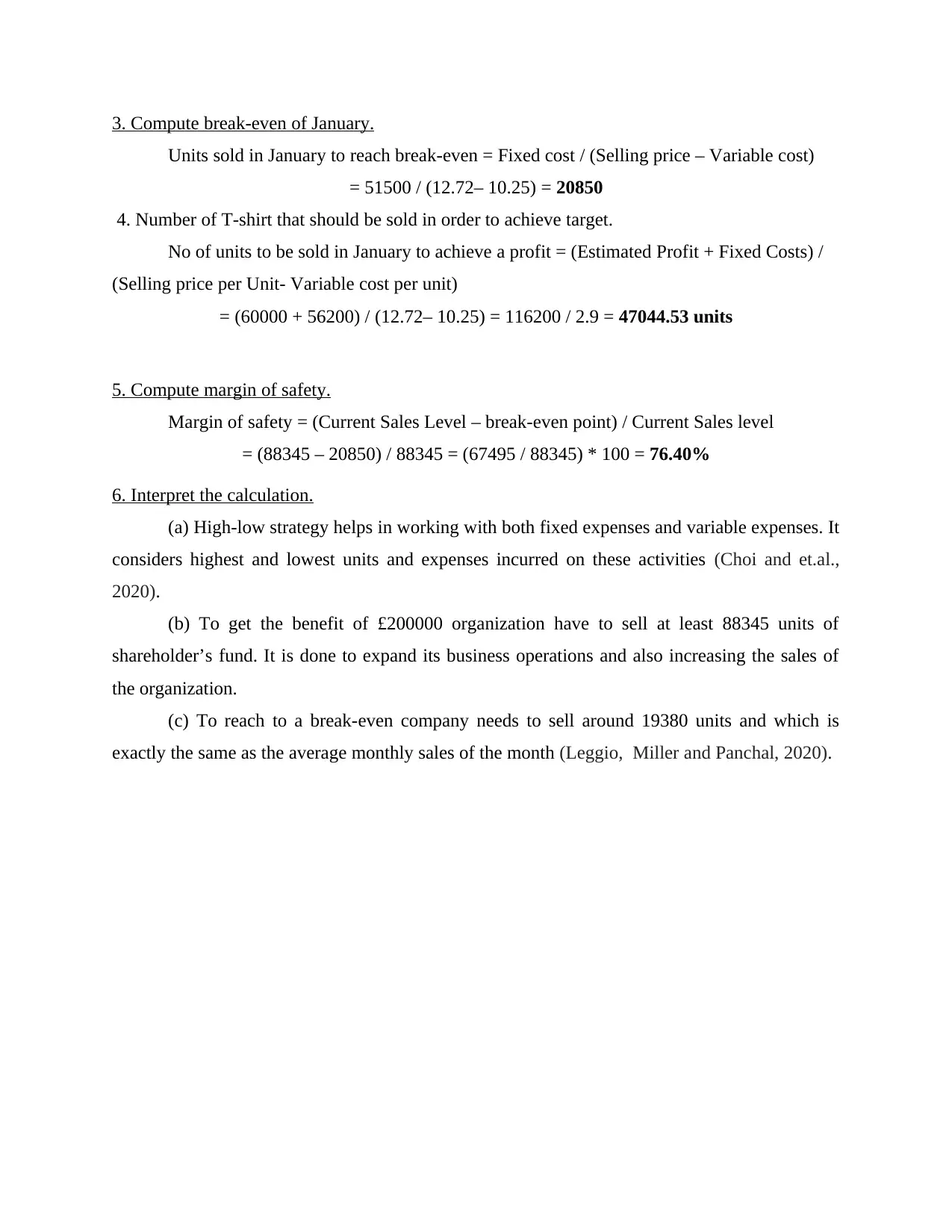
3. Compute break-even of January.
Units sold in January to reach break-even = Fixed cost / (Selling price – Variable cost)
= 51500 / (12.72– 10.25) = 20850
4. Number of T-shirt that should be sold in order to achieve target.
No of units to be sold in January to achieve a profit = (Estimated Profit + Fixed Costs) /
(Selling price per Unit- Variable cost per unit)
= (60000 + 56200) / (12.72– 10.25) = 116200 / 2.9 = 47044.53 units
5. Compute margin of safety.
Margin of safety = (Current Sales Level – break-even point) / Current Sales level
= (88345 – 20850) / 88345 = (67495 / 88345) * 100 = 76.40%
6. Interpret the calculation.
(a) High-low strategy helps in working with both fixed expenses and variable expenses. It
considers highest and lowest units and expenses incurred on these activities (Choi and et.al.,
2020).
(b) To get the benefit of £200000 organization have to sell at least 88345 units of
shareholder’s fund. It is done to expand its business operations and also increasing the sales of
the organization.
(c) To reach to a break-even company needs to sell around 19380 units and which is
exactly the same as the average monthly sales of the month (Leggio, Miller and Panchal, 2020).
Units sold in January to reach break-even = Fixed cost / (Selling price – Variable cost)
= 51500 / (12.72– 10.25) = 20850
4. Number of T-shirt that should be sold in order to achieve target.
No of units to be sold in January to achieve a profit = (Estimated Profit + Fixed Costs) /
(Selling price per Unit- Variable cost per unit)
= (60000 + 56200) / (12.72– 10.25) = 116200 / 2.9 = 47044.53 units
5. Compute margin of safety.
Margin of safety = (Current Sales Level – break-even point) / Current Sales level
= (88345 – 20850) / 88345 = (67495 / 88345) * 100 = 76.40%
6. Interpret the calculation.
(a) High-low strategy helps in working with both fixed expenses and variable expenses. It
considers highest and lowest units and expenses incurred on these activities (Choi and et.al.,
2020).
(b) To get the benefit of £200000 organization have to sell at least 88345 units of
shareholder’s fund. It is done to expand its business operations and also increasing the sales of
the organization.
(c) To reach to a break-even company needs to sell around 19380 units and which is
exactly the same as the average monthly sales of the month (Leggio, Miller and Panchal, 2020).

REFERENCES
Books and Journals
Choi, D.A. and et.al., 2020. Descriptive statistics and visualizing data. Basic Quantitative
Research Methods for Urban Planners, pp.107-132.
Evans, I.S., 2019. General geomorphometry, derivatives of altitude, and descriptive statistics.
In Spatial analysis in geomorphology (pp. 17-90). Routledge.
Leggio, W.J., Miller, M.G. and Panchal, A.R., 2020. Advanced placement paramedic education
for health care professionals: A descriptive evaluation. Journal of Emergency
Nursing, 46(1), pp.44-50.
Tanco, M., Cat, L. and Garat, S., 2019. A break-even analysis for battery electric trucks in Latin
America. Journal of Cleaner Production, 228, pp.1354-1367.
Tompa, E. and et.al., 2021. Break-even Analysis of Respirable Crystalline Silica (RCS)
Exposure Interventions in the Construction Sector. Journal of Occupational and
Environmental Medicine, 63(11), pp.e792-e800.
Books and Journals
Choi, D.A. and et.al., 2020. Descriptive statistics and visualizing data. Basic Quantitative
Research Methods for Urban Planners, pp.107-132.
Evans, I.S., 2019. General geomorphometry, derivatives of altitude, and descriptive statistics.
In Spatial analysis in geomorphology (pp. 17-90). Routledge.
Leggio, W.J., Miller, M.G. and Panchal, A.R., 2020. Advanced placement paramedic education
for health care professionals: A descriptive evaluation. Journal of Emergency
Nursing, 46(1), pp.44-50.
Tanco, M., Cat, L. and Garat, S., 2019. A break-even analysis for battery electric trucks in Latin
America. Journal of Cleaner Production, 228, pp.1354-1367.
Tompa, E. and et.al., 2021. Break-even Analysis of Respirable Crystalline Silica (RCS)
Exposure Interventions in the Construction Sector. Journal of Occupational and
Environmental Medicine, 63(11), pp.e792-e800.
⊘ This is a preview!⊘
Do you want full access?
Subscribe today to unlock all pages.

Trusted by 1+ million students worldwide
1 out of 12
Related Documents
Your All-in-One AI-Powered Toolkit for Academic Success.
+13062052269
info@desklib.com
Available 24*7 on WhatsApp / Email
![[object Object]](/_next/static/media/star-bottom.7253800d.svg)
Unlock your academic potential
Copyright © 2020–2025 A2Z Services. All Rights Reserved. Developed and managed by ZUCOL.



